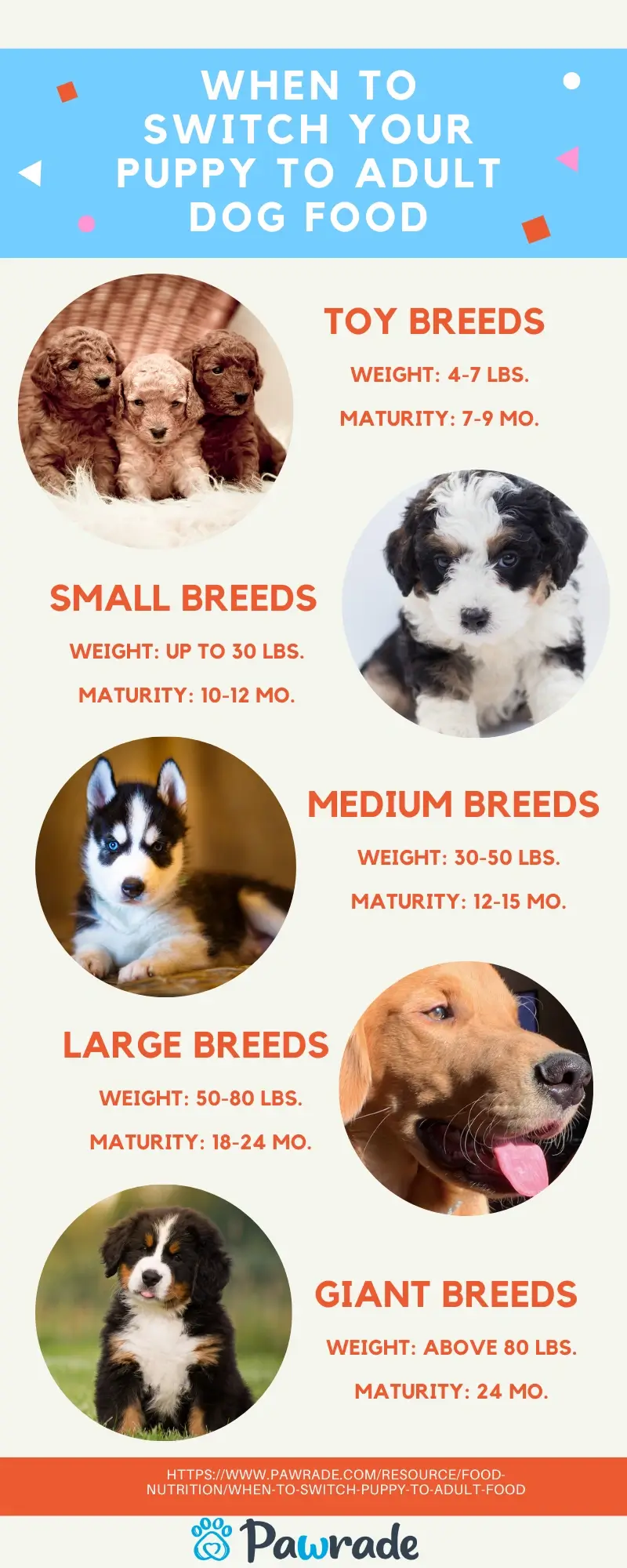You’ve had your new furry friend for a few months. You may be having a difficult time accepting your 4-legged baby is now approaching pre-teen dog years. You’ve decided the time is right to transition your puppy to adult dog food. “How hard can this be?” you think. “I’ll just buy the first bag on sale, scoop it into the bowl, feed my dog twice a day, and done! Easy peasy!”
Not so fast! Transitioning from puppy food to adult food is a thoughtful process. As your dog reaches the age of maturity, which is different for every size and breed, you need to be researching the best adult food to transition from puppy food. You may not know when is a good time to switch your puppy to adult dog food, but we’re here to offer our guide for how and when to switch a puppy to adult food.
Below you’ll learn the difference between puppy and adult food and how long to feed puppy food. You’ll also discover helpful tips on gradually making your dog’s transition to eating adult pet food in the least stressful way for pets.
What’s the Difference between Puppy Food and Adult Food?
Puppy food is specially formulated just for puppies, containing more fat and protein than adult food to feed their growing brain development and bodies. Puppy food also features higher calories and a different balance of nutrients, such as DHA found in mothers’ milk, which helps with puppy brain and vision development.
You will feed your puppy more frequently per day than you will an adult dog. Your young puppy will most likely be fed up to 4 times a day; 3-6 months will be fed around 3 times a day; 6-12 months will experience 2 servings a day. When you stop feeding puppy food, you have to change more than just the food he eats. Portion sizes and the number of meals will also be different.
Adult dog food is specially formulated to maintain your dog’s health for the majority of its active years. While it’s true dogs are considered carnivores, a dog needs much more in its diet than just raw meat or meat-based food. Fruits, grains, and vegetables provide essential nutrients to a dog’s healthy diet.
You’ll notice a dog food aisle features several styles of food beyond a bag of kibble. In addition to kibble, dog food can come in a wet food formula. You may even see a cooler mid-aisle with refrigerated fresh food. No matter the type of food, always check to see if it meets the nutritional needs of your dog’s diet.
When fed to puppies, adult dog food can actually rob much-needed nutrients from puppies because it does not contain what a growing puppy needs to sufficiently support development.
Senior dog food is for those dogs approaching their golden years, usually starting at age 7 and beyond depending on the breed. Energy levels will decrease, and more nutrients will be needed to prevent or support health conditions like joint and arthritis problems, obesity, kidney disease, and diabetes. In addition, some nutrients will decrease, such as protein and the number of calories.
When to Switch A Puppy to Adult Food
You may be wondering how long should puppies eat puppy food. Because there is no one-bowl-fits-all approach, your puppy’s age, breed, and weight work together to determine when to switch to adult dog food.
As your dog continues to grow, you may wonder, “How long do you feed puppy food to them?” and “When can puppies eat adult food?” You also may want to know whether large breeds need to switch to adult food at a similar age as small breed dogs?
It’s a good idea to start thinking about adult dog food when your puppy is around 6-12 months. If you’re wondering how to choose the right dog food, definitely research brands before standing bewildered in the dog food aisle reading labels for the first time! Don’t automatically go for the cheapest brand, and the most expensive brand does not always equal the most quality product right for your dog. You can consult your veterinarian, breeder, friends with dogs, online reviews, or others in dog-related fields about what adult food formula they recommend.
The size, age, and breed of your dog will mean it will mature at different times. This will have an impact on when to switch from puppy food to adult food. A smaller dog will mature more quickly than a large breed. Large and giant-sized breeds will need to eat puppy food longer because they mature later than smaller breeds. Paying attention to these factors will help you know when to stop feeding puppy food.
- Toy breeds weighing 4-7 lbs. can mature as early as 7-9 months old
- Small breeds up to 30 lbs. mature around 10-12 months of age
- Medium breeds up to 50 lbs. mature between 12-15 months old
- Larger dog breeds weighing 50-80 lbs. can mature at 18-24 months old
- At over 80 lbs., giant dog breeds can take up to 2 years to reach full maturity
Why You Need to Switch to an Adult Dog Food Formula
Now that we’ve explored when to switch a puppy to dog food for adults, it’s important to understand why dogs require a change in diet in the first place. Switching to adult dog food from puppy food is not just an owner preference – it is a health necessity. If you’re wondering, “Can adult dogs eat puppy food?” the short answer is yes, but it isn’t ideal and can cause issues for your pup down the line. If you continue feeding your puppy specially formulated puppy food past the recommended weight and age, your puppy could be at risk for obesity due to the higher calorie content in puppy food. Pet obesity causes all sorts of health problems and is associated with a lesser life span, so switching foods should be taken seriously.
Most dogs are neutered or spayed around 6-12 months of age, and their energy levels will decrease as a result. Therefore, continuing to feed puppy food designed for high-energy dogs could affect your growing adult dog’s behavior in unfavorable ways.
How to Transition a Puppy to Adult Dog Food
If you switch abruptly, your dog could get a bad upset stomach, causing discomfort and pain for your puppy and potential messes to clean up for you. That’s why in addition to figuring out when to switch a puppy to adult food, you also need to have a strategy for making the transition easy and safe.
The key to switching dog foods is to go slowly with a step-by-step schedule. It’s important to not assume you’ll be feeding at the same times and the same amount every day. With puppy food, you may be used to splitting the daily allowance into 3 small feeding times. However, with adult dog food, you may be serving only morning and night portions. The measurements will be different as well as your dog’s weight increases, so it’s important to read all labels and follow the brand’s guidelines.
Use a gradual approach when transitioning from puppy food to adult dog food. Follow our schedule over a week’s time to prevent gastrointestinal issues due to sudden food changes.
Days 1-2: 25% adult food and 75% puppy food
Days 3-4: You can feed half adult, half puppy food
Days 5-7: 25% puppy food and 75% adult food
Days 8 and beyond: Full servings of adult food
Pawrade Takes a Puppy First Approach to Puppy Nutrition
We care about the health of our puppies for sale. That’s why we follow our Puppy First approach. Our program is unique and designed to ensure the livelihood and well-being of every puppy is at our fundamental core.
We work with hand-selected breeders that feed their puppies high-quality nutrition and will have advice for selecting the right adult food for your puppies. Find your new canine companion by checking out our dogs for sale.



